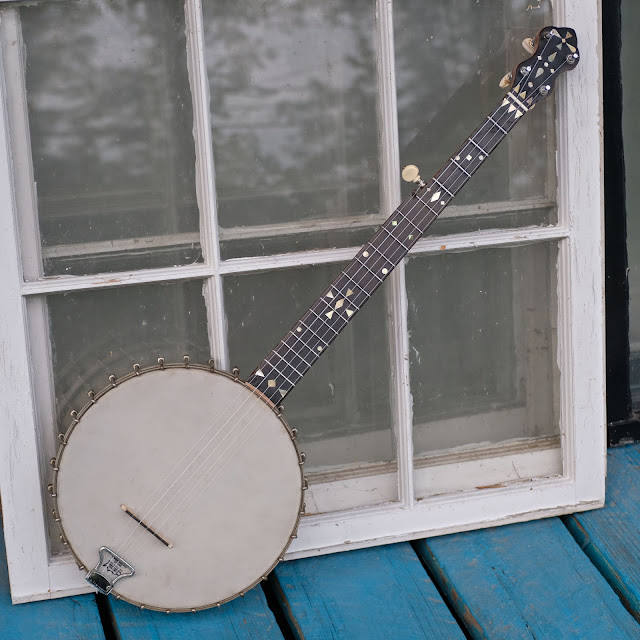1890s A.C. Fairbanks 5-String Openback Banjo
Judging by the wear, geared tuners, and funky refinish (or overcoat) job, this banjo must've been played most of its life -- first by its proper generation and then probably later as a '60s and '70s folkie instrument. Its owner brought it to me in a pretty deteriorated state -- action way high, grungy, strung with steel, and needing a makeover.
The neck was also backbowed in a bad way in the first 4 frets, and solving the fret issue and a crumbling/damaged dyed-maple fretboard was where most of my energy went. I solved the backbow by adding oversize frets (of decreasing size) starting at the first fret and then moving towards the 5th. To counter some twist and general funkiness in the area, I set these in gently and had to leave some of the tang exposed in a few spots, so I used the wood dust and superglue wicking trick to build up some support for the frets. After that, I gave the instrument a ret level/dress, cleaned it up, and gave it a good setup with Aquila Nylgut strings. These are very much like the sound and tension of the gut that would've originally been on the banjo, though with the benefit of a plain low D string.
Fairbanks (out of Boston) is the maker that became more well-known as Vega in the 1900s and it's always been a good brand. This instrument was clearly well-built when it was new and it probably dates from the early 1890s judging by the folksy inlay style and lack of any serial numbers.
Specs are: 25 7/8" scale, 1 1/4" nut width, 1" string spacing at the nut, 1 3/4" string spacing at the bridge, 11" head, and 2 1/2" side depth.
Woods are: cherry(?) neck, ebonized maple fretboard and headstock veneer, and mystery (black-painted) rim.
Much of the hardware is original, though it has replacement tuners, head, bridge, and tailpiece.
I actually like that the tailpiece has a downpressure bar. I don't get to hear a lot of gut/Nylgut-strung banjos with extra downpressure at the tailpiece (most tailpieces are No-Knot or similar in style for them) and I'm liking the extra punch it affords this banjo.
These days I try to shim the neck angle back to allow for a 5/8" height bridge, too, and that's what's on this one. I figure if I can get a 5/8" on, that way if the instrument drifts after setup to higher action for whatever reason, the owner can still pop a standard-issue 1/2" on and get good action.
The bolt-adjustable neck brace on the old Fairbanks and Fairbanks/Cole banjos are one of the few designs from the period that actually work great.















Comments